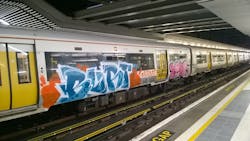Protecting the Investment of Public Transit with Specialty Films
Each day, millions of riders depend on public transportation to get them to jobs, homes and daily activities. Just last year, American riders took a whopping 10.1 billion trips on public transportation. Not only is public transportation massively relied on by passengers, it’s also an important aspect of a robust economy, with every $1 billion invested supporting and creating more than 50,000 jobs.
A solid public transit system must start with functional vehicles, which can be a massive investment for governments and the transit industry. A single transit or coach bus can cost anywhere from $205,000 to $375,000, with a light rail vehicle costing upwards of $2.4 million (source). Multiply these figures by every city using public transportation around the world, and the investment made into public transit becomes astronomical. The need to protect that investment becomes essential to daily commutes and goes hand in hand with a thriving economy. One tactic to protect public transit vehicles and ensure investment is spent appropriately, is the application of advanced films to side windows, cab windows, interior windows, exterior paint and other surfaces.
How film protects mass transit vehicles
• Safety and Impact Protection – Public transportation is 10 times safer per mile than traveling by automobile (source). Film adds an extra layer of protection to ensure continued safety. When film is professionally applied, the product offers a measure of protection from the hazards of flying glass fragments in the event of an accident or storm. Film also deters or at least delays unwanted entry. An unfortunate truth is that public transportation vehicles are often targets of terrorist attacks given their sheer number of riders in a condensed area. Film can add a layer of safety as it will hold the glass together. professionally installed impact-resistant films are essential. When ordinary non-tempered glass breaks, it poses considerable danger, but with filmed glass, this hazard may be significantly reduced.
• Anti-Graffiti Properties – Unfortunately, public transit vehicles are often the target of graffiti and vandalism, and cities are facing the rising costs of the clean-up. A few years back, the San Francisco Municipal Transportation Agency reported over 1,100 graffiti incidents on its buses and light-rail vehicles, as well as at bus stops, each week and the price of cleanup exceeded $12.5 million a year – the equivalent of putting three new light-rail vehicles in service (source). Just last year the Chicago Transit Authority reported that graffiti and other vandalism cost the CTA a total of more than $1.3 million over the last three years. Specially designed anti-graffiti films can help mitigate these costs and protect public property. These optically clear films act as a sacrificial barrier to guard against graffiti, etching, and general wear and tear from highly trafficked areas. Once vandalized by graffiti, the film can easily be removed and replaced without leaving residue, which can greatly improve the turnaround time for maintenance and servicing, not to mention reduce the costs involved in cleanup. There are different types of anti-graffiti films for city staff and transit authorities to consider. Before installation, ensure the film chosen offers the highest level of testing certification for glass and other surfaces.
• Anti-Spall properties – Anti-spall films have properties which improve weight management, performance and cost for ballistic glass manufacturers. Anti-spall films offer a scratch resistant layer on the hard coat exterior of vehicles with spall protection. These films also offer flammability, abrasion and chemical resistance along with excellent peel strength and can be applied as an interlayer in multi-laminate glass constructions.
• Meeting regulations – Public transit vehicles must comply with numerous regulations to ensure passenger safety. Professional films are tested and certified to make sure once applied, they’re complying with all International, state federal regulations. International certifications of films include fire testing, safety glazing for motor vehicles, surface burning characteristics and toxic gas generation.
• Solar control – Specialty films also offer infrared radiation rejecting properties and solar heat control, blocking 99% of harmful UV rays. This helps the driver have a clearer view of the roadway and offers a more comfortable ride for the passengers –especially those traveling during the warmest months of the year. This type of film also reduces fading of the vehicle’s interior, adding to its longevity. Film reduces the amount of sunlight shining in, resulting in a more energy efficient vehicle with an air conditioning system that doesn’t need to work as hard.
Passengers in cities across the country rely on public transit to take them from point A to point B safely. Developing strategies to improve safety, service life and reduce maintenance problems are essential to the longevity of a flourishing public transportation system. When planning future improvements to transportation fleets, consider film’s benefits as it saves money, time and adds an extra layer of safety and durability keeping vehicles on the road longer.
Steven Sorrentino is director of specialty films for Madico Inc., and can be reached at 781.491.9876 or via LinkedIn.
